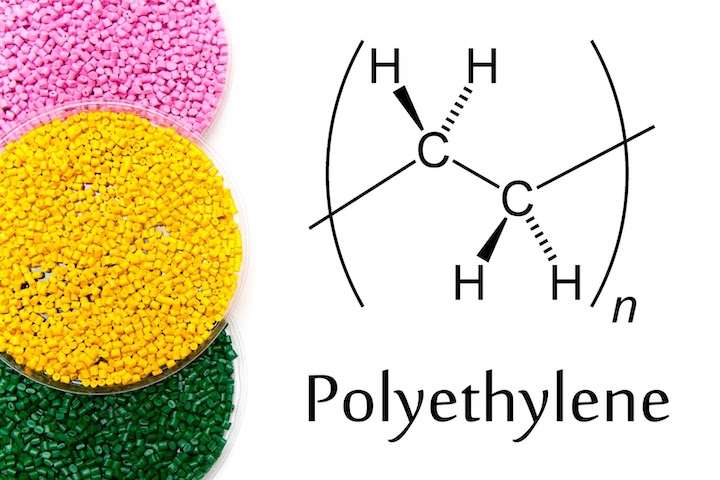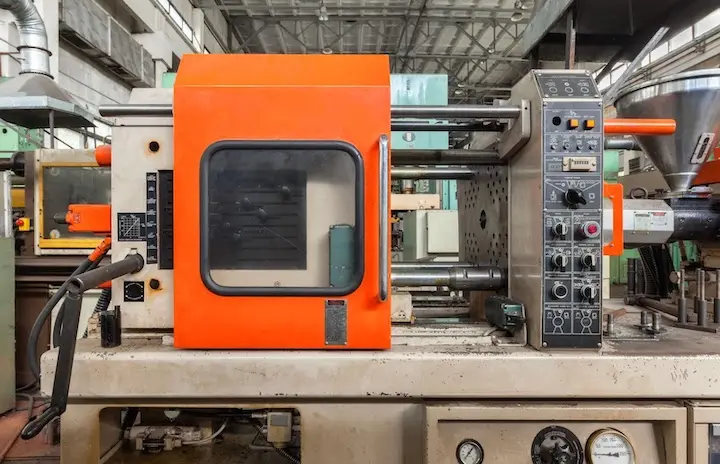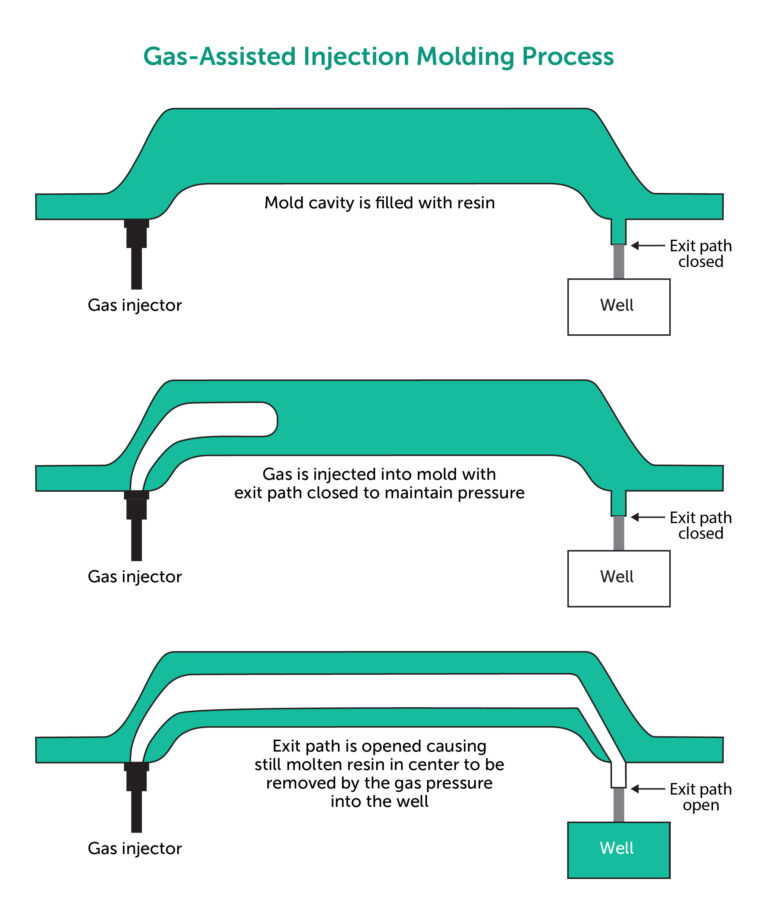Time to read: 6 min
Polyethylene injection molding produces parts from polyethylene (PE), the world’s most commonly used plastic material. This thermoplastic polymer has a variable crystalline structure that, in part, determines its material properties. With plastics, the degree of crystallinity has a significant effect on hardness and density. In turn, this affects attributes such as stiffness and flexibility. Applications for polyethylene range from packaging and pipes to electrical, medical, and industrial products.
Types of Injection Molded Polyethylene
Five types of polyethylene plastic are commonly injection molded.
- Low-density polyethylene (LDPE)
- Linear-low-density polyethylene (LLDPE)
- Medium-density polyethylene (MDPE)
- High-density polyethylene (HDPE)
- Ultra-high molecular weight polyethylene (UHMWPE)
Polyethylene with a lower density (e.g., LDPE and LLPDPE) has lower crystallinity and greater flexibility. PE with a higher density (e.g., MDPE and HDPE) has higher crystallinity and greater stiffness. Crystallinity is also related to molecular weight, which affects both material properties and processing parameters.

Polyethylene Properties and Injection Molding Guidelines
Polyethylene is generally lightweight, chemically resistant, and electrically insulating. The amount of stiffness and strength varies by PE type, but injection molded PE is often used in parts that need to withstand stress or strain. For designers, selecting the right type of polyethylene may include tradeoffs since higher stiffness is also associated with greater brittleness. Different PE plastics also provide different types of resistance to specific chemicals, or to environmental factors such as sunlight.
If you’re thinking about selecting polyethylene plastic for your next injection molding project, it’s important to understand the properties, advantages, disadvantages, and applications of each type of PE plastic. This article addresses these subjects, but for a successful project, you’ll also need to follow injection molding best practices — so check out our Injection Molding Design Guide, a free e-book available for download, has the info you need:
Download Fictiv’s Injection Molding Design Guide
Polyethylene Processing Considerations
In addition to material properties and injection molding guidelines, it helps to understand four key processing parameters that injection molders need to control.
- Melt temperature
- Mold temperature
- Injection speed
- Injection pressure
As a designer, it’s not your job to control these processing parameters; however, a skilled injection molder will make getting them right a priority.
Melt temperature is the temperature of a polymer as it exits the nozzle and enters the mold. This processing parameter affects viscosity, a measure of resistance to flow. It also affects molecular weight, which determines how far a plastic can stretch before rupturing. Depending on the type of polyethylene, melt temperature can vary significantly.
In semi-crystalline materials like PE plastic, the mold temperature affects the degree of crystallinity in the polymer. That’s because crystals only form at temperatures below a polymer’s melting point, but above its glass transition (Tg) temperature. With polyethylene, the mold temperature can also vary significantly, depending on the type of PE plastic that’s processed.
For an injection molder, it’s important to set the injection speed to fill the mold quickly and set the injection pressure so that it’s relatively high. And, because there are important differences between polyethylene types, designers may need help comparing the material properties of LDPE, LLDPE, MDPE, HDPE, and UHMWPE plastics — the following sections explain what designers need to know.

LDPE Injection Molding
Low-density polyethylene (LDPE) remains flexible even at low temperatures, and has good strength relative to its density. It can withstand a significant amount of stretching before it breaks, and is odorless, sterile, and watertight. LDPE also maintains its structural integrity and has low water absorption. Applications for injection molded LDPE include hose fittings for water supplies.
LDPE is susceptible to stress cracking, however, and has lower strength and stiffness than other types of polyethylene. Although LDPE has good resistance to alcohols, dilute alkalis, and acids, it has limited resistance to mineral oils, oxidizing agents, and some types of hydrocarbons. This low-cost polymer is also highly flammable and offers poor resistance to ultraviolet (UV) light, which makes it unsuitable for outdoor applications.
With specific types of additives, however, LDPE can have UV resistance and even serve as an anti-static barrier for sensitive electronic components. Importantly, LDPE is relatively easy to process during plastic injection molding. LDPE has a melt temperature between 160°C to 260°C and post-mold shrinkage is between 1.5% and 3.5%.
LLDPE Injection Molding
Linear-low-density polyethylene (LLDPE) is not only flexible and stretchable, but also puncture and impact resistant. Compared to LDPE, injection-molded LLDPE has greater chemical resistance, better mechanical characteristics at high and low temperatures, high surface gloss, and good resistance to cracking. This type of PE plastic also has good stress cracking and impact resistance while providing a barrier to water.
LLDPE is similar in structure to HDPE but has a higher softening point and a higher strength and relative breaking extension. LLDPE is also more difficult to process than LDPE and has a narrower temperature range for heat sealing, which is used in packaging applications and industrial laboratories. Applications for injection molded LDPE include enclosures, caps, snap fits, and lids.
MDPE Injection Molding and HDPE Injection Molding
Medium-density polyethylene (MDPE) is durable with high impact resistance and good chemical resistance. It has good shock and drop resistance and can resist many types of chemicals, including diesel fuels, acids, and oils. MDPE resins provide higher stiffness than LDPE and LLDPE, but less than HDPE plastic — so it’s an “in-between” option. Despite its advantages, MDPE has poor resistance to UV light and to solvents.
High-density polyethylene (HDPE) is more rigid because of its high crystallinity, but is still a relatively flexible plastic. Compared to other forms of polypropylene, HDPE has a higher tensile strength. This low-cost polymer provides good processability and combines excellent electrical insulating properties with low water absorption. Some HDPE grades are designed to withstand environmental stress-cracking or to provide high stiffness or low shrinkage.
HDPE’s high mold shrinkage is a disadvantage, however. Most of this shrinkage occurs during cooling and can affect dimensional stability and part tolerances. Although it’s possible for an injection molder to accurately predict the amount of shrinkage, molded HDPE parts that shrink unequally can warp, a common molded part defect. HDPE is also susceptible to stress cracking and has poor UV resistance and low heat resistance. Some grades offer improved performance properties, such as resistance to sunlight.
With plastic injection molding, HDPE has a melt temperature between 200°C and 300°C and a mold temperature between 10°C and 80°C. A higher mold temperature can improve the appearance of a molded HDPE part and provide a shinier and glossier surface. Mold shrinkage ranges between 1.5% and 4%, depending on processing conditions and the thickness of the final component.

Ultra-High Molecular Weight Polyethylene (UHMWPE) Injection Molding
Ultra-high molecular weight polyethylene (UHMWPE) has excellent mechanical properties, such as high abrasion resistance and impact strength. With its low coefficient of friction, it also provides good abrasion and wear resistance. Medical applications for UHMWPE include the articulating surfaces of joint replacements used in hip, knee, ankle, and shoulder surgery.
Because UHMWPE is almost totally inert, this type of polyethylene can be used in corrosive or aggressive environments at moderate temperatures. It remains resistant to many solvents at higher temperatures, but with notable exceptions such as aromatic and halogenated hydrocarbons. The specific UHMWPE grade determines the amount of resistance wear, chemicals, and the impact that the material provides.
In plastic injection molding, molecular weight is significant not only because of its relationship to crystallinity, but also to a thermoplastic’s melt rheology. Specifically, higher molecular weight resins like UHMWPE have higher viscosity and a higher pressure drop in the injection mold cavity during filling. Consequently, higher packing pressure must be used to compensate for the cavity pressure drop. Otherwise, the lower pressure melt will result in shrinkage in the final part.
Choose Fictiv for Polyethylene Injection Molding
Polyethylene injection molding offers many advantages, but it can also pose challenges during material selection, part design, and processing. With Fictiv, your operating system for custom mechanical parts, you get expert design for manufacturing (DFM) feedback along with your quote and manufacturing guidance every step of the way. Our injection molding expertss understand the properties of each PE plastic and our global network of manufacturing partners have experience injection molding LDPE, LLDPE, MDPE, HDPE, and UHMWPE.
Ready to get started? Create a free Fictiv account and upload your design to get a quote today — we produce complex injection molded parts at ridiculous speeds!










